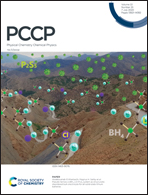Real-time observation of molecular flattening and intersystem crossing in [(DPEPhos)Cu(i)(PyrTet)] via ultrafast UV/Vis- and mid-IR spectroscopy on solution and solid samples†
Abstract
The primary photo-induced processes in the mononuclear, heteroleptic Cu(I) complex [(DPEPhos)Cu(PyrTet)] (1), relevant for OLED applications, were investigated in various solvents and in solid state samples via femtosecond (fs) time resolved UV/Vis and fs time resolved mid-IR transient absorption spectroscopy (TA) with MLCT excitation around 340 nm. UV/Vis fs-TA on 1 in solution reveals (i) a severe blue-shift of excited state absorption on the time scale of a few picoseconds (τ2) that is not observed in solids, and (ii), on the time scale of several tens of picoseconds (τ3), a process with very similar dynamics in all samples. Mid-IR fs-TA in solution indicates structural changes with τ2. Transient absorption anisotropy experiments temporally resolve a viscosity-dependent change of the excited state transition dipole moment orientation with τ2, as quantitatively predicted for the relaxed S1-state via TD-DFT. The results strongly suggest flattening distortion (FD) and structural rearrangement of the PyrTet-moiety to occur on the time scale of τ2 in liquid phase, and to be suppressed in solid phase. Moreover, intersystem crossing (ISC) is assigned to the process described by τ3, in line with its direct observation via time-resolved luminescence spectroscopy on 1 by Bergmann et al. (Sci. Adv., 2016, 2, e1500889). Overall, the use of structure-sensitive methods and the direct comparison of different preparations of 1 (i.e. solution vs. solid state), are a unique basis for a clear assignment of spectro-temporal characteristics to fundamental deactivation processes such as FD and ISC.
![Graphical abstract: Real-time observation of molecular flattening and intersystem crossing in [(DPEPhos)Cu(i)(PyrTet)] via ultrafast UV/Vis- and mid-IR spectroscopy on solution and solid samples](/en/Image/Get?imageInfo.ImageType=GA&imageInfo.ImageIdentifier.ManuscriptID=C9CP05749H&imageInfo.ImageIdentifier.Year=2020)


 Please wait while we load your content...
Please wait while we load your content...